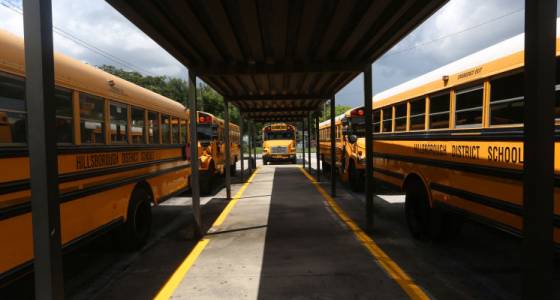TAMPA — With the merger of two north Tampa schools, the Hillsborough County School District is finally working to make sense of where it sends its students and how they get there.
15 Hours Ago
5 Months Ago
4 Months Ago
Van Buren Middle, which is more than half empty and earned a string of D grades in recent years, will be combined with Cahoon Elementary, a magnet school specializing in animal science.
The adjacent campuses are just east of Sulphur Springs and south of Busch Boulevard.
When the changes take place in August of 2018, Cahoon will no longer be magnet. Students who live near the school, or are admitted through choice, will be able to take part in the animal science program. But those outside the boundaries will not be guaranteed a bus ride.
All these plans are preliminary, and officials say they will have many community meetings before anything is firmed up.
The plan affects far more than Cahoon and Van Buren.
For years, as elementary schools near Cahoon have filled beyond capacity, the district has been busing children to Clark and Hunter's Green elementary schools in New Tampa.
But, with suburban homebuilding back in full swing, 1,500 new families are expected in New Tampa. By ending the busing, the district can accommodate the new students without building a new school. "It's really a $25 million motivator," said Chris Farkas, the district's chief operating officer, referring to the approximate construction cost.
The merger also helps answer the question of what to do when the Museum of Science and Industry, which has its own district-run school, relocates to downtown Tampa.
Right now children who cannot find room at MOSI attend Pizzo Elementary, or other schools when Pizzo becomes full, Farkas said. Sometimes buses travel from one apartment complex to three different schools. And the erratic pattern hurts Pizzo, which gets about half of its 800 students from other school zones.
"It's not a conducive learning environment, not knowing who your students are and what your feeder schools are," Farkas said.
An important piece of the plan is a prekindergarten program, district officials said. With kindergarten readiness lacking in many schools, they want children to be well prepared as they move through the primary grades.
Of the 40 schools that landed on the state's list of 312 low-performing elementary schools this year, many are located close to Cahoon and Van Buren: Kimbell, Miles, Pizzo, Shaw, Witter and the Village of Excellence charter school, to name a few.
There is no way to tell how easy it will be to merge the schools. Nearby Sulphur Springs Elementary began a conversion to a K-8 school two years ago. It added grade six, then needed an extra year to adjust to its new role as a middle school. Grade seven will be added in August, Farkas said.
And race could become a factor as the plan is communicated to area residents.
Van Buren is 60 percent black and under 5 percent white. Cahoon, with the magnet program, is 52 percent black and 17 percent white.
"We're always concerned about racial make up at a school," Farkas said. "That's all the more reason for kids having a viable option within that community."
As complicated as the Cahoon-Van Buren merger promises to be, it is just the first of many such reconfigurations as the district tries to correct a multitude of inefficient zoning situations.
Schools, especially middle schools, have enrollments as low as 46 percent of their capacity and as high as 117 percent. And some of the largely empty schools are magnets, which means the district is paying to bus students from as far as 25 miles away.
"This is a small snapshot of what the future may hold," Farkas said.
Despite the work, district leaders say they must find ways to economize at a time of uncertain funding and continuing concerns about its reserve accounts.
Following recommendations from the Gibson Consulting Group, district leaders are also considering a change to bell schedules that would allow more buses to serve three schools a day instead of two.
Those conversations are preliminary, Farkas said, with the goal of putting a full hour between high school, elementary school and middle school start times. The typical high school day now begins at 7:33 a.m. while elementary schools begin at 8 a.m. and middle schools at 9 a.m.
Forty percent of the bus drivers have only two schools, so spacing the trips out would improve efficiency, Farkas said.
More important, he said, "if we have an hour in between, it gives us a much better chance to of getting the students to school on time for breakfast and picking them up on time."
Contact Marlene Sokol at (813) 226-3356 or msokol@tampabay.com.
Our editors found this article on this site using Google and regenerated it for our readers.












